Menu
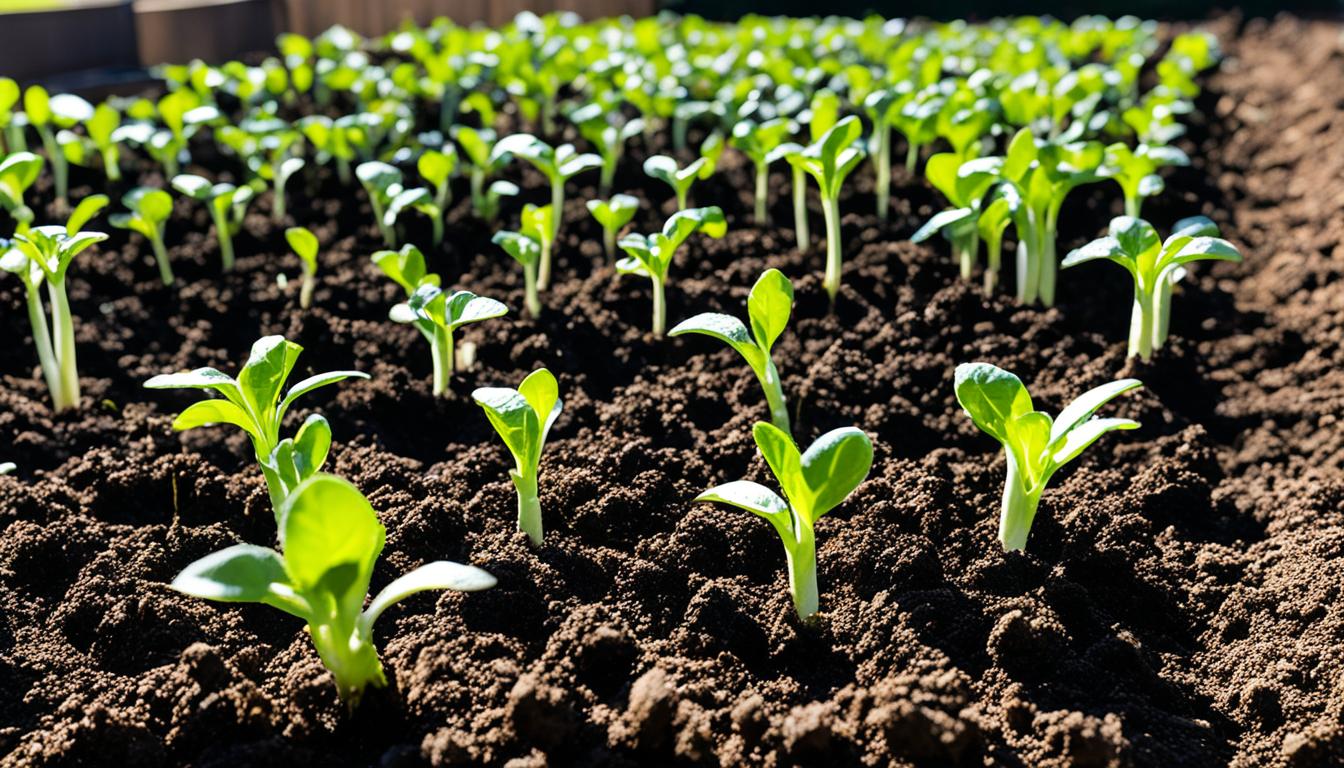
Amending garden soil is best done in late summer or early autumn. With spring around the corner, I’m ready to kick-start my garden. It’s crucial to focus on our soil now for a lush and healthy garden later.
Start by cleaning up winter debris and trimming damaged plants. This helps new growth and makes your garden look better. Clear out old mulch to warm the soil for new plants.
Turning over settled mulch aerates the soil. New mulch keeps it healthy. Doing this now helps make your garden thrive in summer.
Testing your soil is a smart move. Soil test kits are handy and tell you what your soil needs. Adding compost is great for the soil. It’s easy with a tumbler or a DIY bin. Just remember, 2/3 brown and 1/3 green material is perfect for composting.
If composting isn’t your thing, you can try layering leaves and clippings. Water, turn, and let the sun do its job for good compost. This makes your soil rich and ready for planting.
For more detailed insights on soil health improvement, you can visit an informative resource on practical ways to improve your garden soil.
Starting my spring clean-up means taking care of key garden tasks. This makes the garden a better place for plants to grow. It also ensures a bright, healthy garden.
I begin by getting rid of winter’s mess. I clear away leaves and mulch from the ground. This lets the soil get sunlight and air, which helps new growth. Keeping the ground clean also helps air and water to move easily.
Next, I look for branches that need to go. This step is vital for the plants’ health. Removing unhealthy branches stops diseases and pests. It helps fresh, healthy shoots to grow. Studies show that cutting can lower disease risk by 40%.
Choosing the right time for pruning is crucial. For example, I wait to prune spring flowers like lilacs until they bloom. This means I won’t accidentally cut off the flowers. It ensures the garden looks lovely all season. I always watch my plants’ schedules to keep them healthy and pretty.
A detailed spring clean-up is key for healthy, beautiful gardens. With careful pruning, taking care of shrubs and trees, the garden is ready for the best growth. After these steps, everything is set to flourish in the warm months ahead.
| Task | Benefit |
|---|---|
| Removing Winter Debris | Improves soil exposure to sunlight and air |
| Cutting Back Damaged Branches | Reduces disease and pest risk, promotes new growth |
| Timing Seasonal Pruning | Preserves blossoms and enhances plant vitality |
The spring thaw in Grand Rapids signals it’s time to uncover our garden beds. This is essential for a successful garden in the coming months. I’ll share some steps to get this done properly.
First, we need to remove the old mulch from last autumn. It’s important to do this carefully to avoid damaging the beds. This step lets the soil underneath get warmer, which helps new plants grow strong in spring.
Next, refresh the mulch left from before by turning it over. This action keeps the mulch working well at keeping the soil warm. It also helps to protect and feed the garden beds.
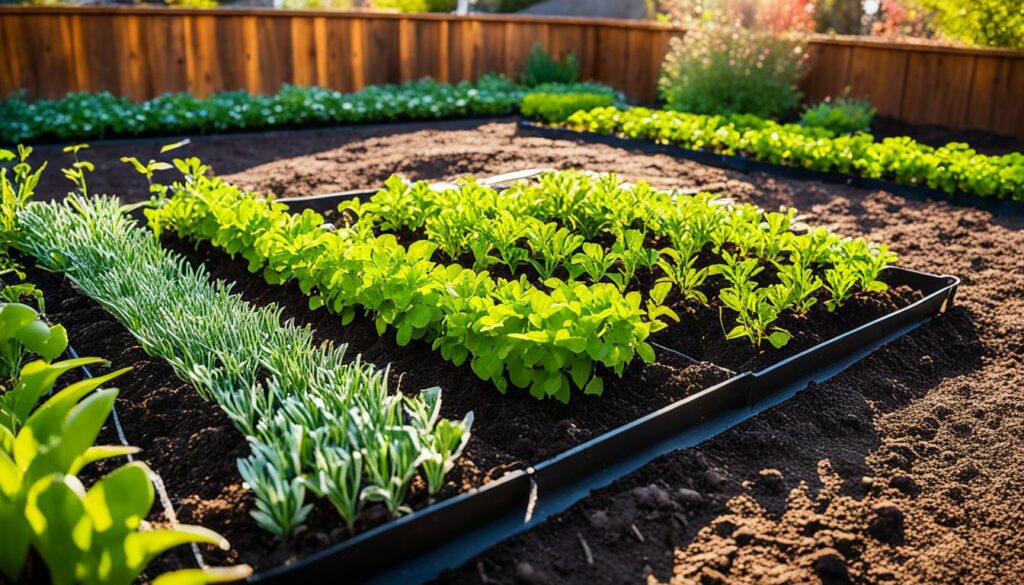
Finally, add a fresh layer of mulch. Make sure the layer is no thicker than 3 inches. This step is critical for soil health and ensuring plants grow well all season.
| Key Activity | Detail |
|---|---|
| Clear Fall Mulch | Removes old mulch to allow soil warming |
| Refresh Existing Mulch | Turn over mulch to revitalise structure |
| Add New Mulch | Layer no more than 3 inches for optimal insulation |
Knowing the status of your garden soil is key for healthy plants. Soil testing checks for soil acidity and nutrient deficiency. These insights are crucial for a productive garden. By regularly testing your soil, you can learn its composition. This helps you make smart choices about what it needs.
The soil’s pH level affects how plants get nutrients. Tests look at this and more, painting a full picture of the soil’s health. The Texas A&M AgriLife lab can check your soil in about two weeks. This is valuable information for treating your soil just right.
Soil tests also look at key and minor nutrients like nitrogen, and zinc. This knowledge stops you from over or under-fertilising. Good care, guided by these tests, promotes health in your plants with a better harvest.
For those gardening at home, a DIY soil testing kit can be very helpful. These kits measure pH and nutrients, helping you know what your soil needs. January or February is best for testing, ahead of spring plantings. Flowerland offers detailed soil tests for specific and effective soil care.
| Test | Measures | Typical Cost |
|---|---|---|
| Soil pH | Acidity/Alkalinity | $10 |
| Nutrient Analysis | Macronutrients & Micronutrients | Additional Costs Apply |
| Organic Matter | Soil Composition | – |
| Limestone Requirement | Correction for Acidity | – |
For a great garden, you need to care for the soil. This means adding the right fertilisers and organic stuff. A good mix makes plants grow well. By using these methods, your garden can flourish all year.
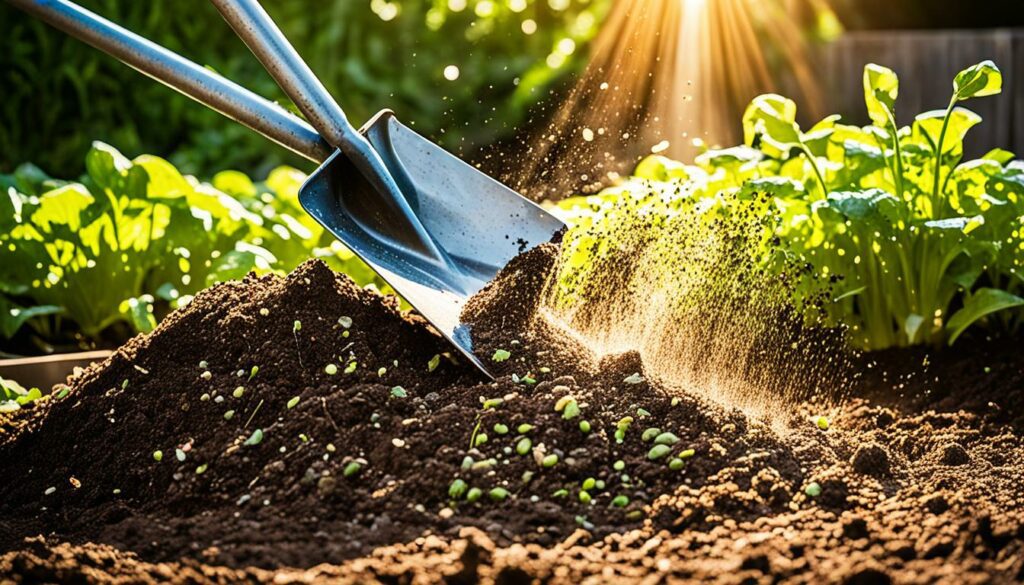
Adding things like compost makes the soil better. It makes the soil hold water and air well. This helps good bacteria grow, which is great for plants. Also, using cover crops can add to the soil’s health. It means more profit for farmers too.
Knowing what fertilisers to use comes from soil tests. The right choice puts back what the soil lacks. It balances nutrients for the best plant growth. Choosing well also means less impact on the environment.
Green manures and animal manure boost soil nutrients. They connect farm animals with crops and both benefit. The soil gets better, earthworms increase, making the soil work hard. This adds to biodiversity, making the soil more productive.
| Cover Crop Benefits | Impact |
|---|---|
| Soil Carbon and Organic Matter | Improves soil health and profitability |
| Soil Nutrient Management | Reduces fertiliser needs and prevents runoff |
| Population of Earthworms | Enhances soil aeration and structure |
| Biodiversity | Increases soil health and crop yields |
| Soil Erosion Reduction | Maintains topsoil integrity |
| Integration with Livestock | Mutually beneficial for soil health and profits |
Spring is an important time to focus on soil health. This is crucial for strong plant growth and a healthy garden. We need to look at soil’s components, the importance of microbial life, and the value of balanced soil pH.
Soil has mineral particles, organic matter, and microorganisms. They all work together to help plants thrive. Imagine, it takes 500 to 1,000 years to make just one inch of topsoil.
Yet, water and wind wash away 20 to 32 billion tons of topsoil every year. In Arkansas, water alone takes away one to five tons of soil per acre every year. This makes protecting our soil very important.
Healthy soil bacteria are crucial for plant growth. They break down things like dead leaves, making food for plants. In Arkansas, the Arkansas Soil Health Alliance (ASHA) has shown that boosting these tiny workers means farms need less water and fewer chemicals.
The right soil pH helps plants absorb nutrients better. Whether soil is too acidic or too alkaline can affect how well plants can get food. Most plants like a slightly acidic to neutral pH.
You can adjust soil pH by adding the right stuff to your soil. This keeps your garden healthy and helps plants grow strong and steady.
There is a lot of work going into soil health all over the country. Groups like the Soil Health Institute and programs like “Unlock the Secrets in the Soil” offer help and knowledge. They aim to protect and improve our soil.
Making compost turns garden waste into a healthy mix. This mix helps soil and plants grow better. In places like Utah, compost mixed for local needs, such as The Dirt Bag’s, boosts gardens a lot.
To start making great compost, pick a spot that’s convenient and a bit shady. Add green stuff like veg scraps and grass with brown bits like leaves. Mixing these and checking air and moisture helps everything break down into compost.
Getting the compost’s mix right means keeping a 30:1 balance of carbon to nitrogen. This helps good bacteria and fungi grow, making a rich compost. Turning the pile often keeps it airy and stink-free.
After three to six months, the compost is ready. Adding this to your garden bed makes the soil great. It improves how water flows, gives plants food, and makes them stronger against sickness.
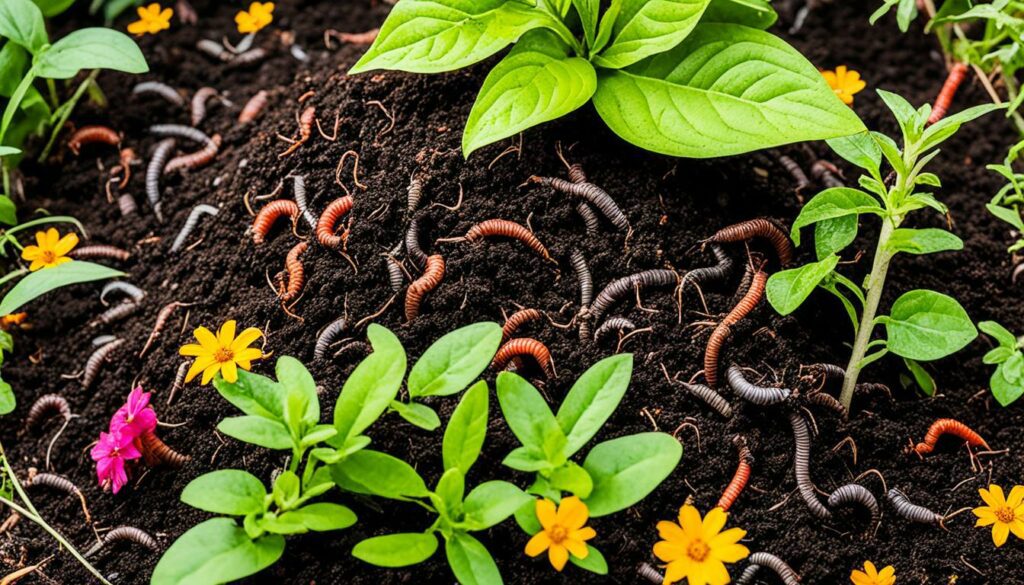
| Benefits of Compost Soil | Details |
|---|---|
| Healthier Plants | Empowered by balanced nutrient uptake and improved disease resistance |
| Increased Yields | Optimised growing conditions yield abundant harvests |
| Reduced Water Requirements | Enhanced soil moisture retention reduces irrigation needs |
| Improved Soil Texture | Enhanced aeration and drainage properties support root development |
The Dirt Bag’s Organic Mountain Compost and Garden Soil Plus are top blends. They keep soil nutrients in check, cutting the need for extra chemicals. The Dirt Bag is great at making compost for Utah’s gardens.
It’s vital to know about the various soil types and how to work with them. Doing so can really boost your garden’s growth and health. There are three main types: clay, sandy, and loamy. Each has its own set of challenges and advantages. Careful management is key to tackling these effectively.
Clay soil is dense and hard, causing problems like poor drainage. Turning it into better soil means adding things like compost or well-rotted manure. These break up the hard bits, making it lighter and letting plants breathe. Adding gypsum also helps a lot with clay improvement.
Sandy soil drains water too quickly and struggles to keep nutrients. To make it better, mix in peat moss or compost. This makes it hold water and nutrients longer, acting like a sponge. With the right care, sandy soil can become very fertile.
Loamy soil is seen as the best for gardening because it’s balanced. It drains well and keeps nutrients. Keeping it top-notch is all about adding organic matter regularly. This could be something like mushroom compost. Making small changes with lime or sulfur when needed also helps. This ensures your loamy soil continues to support healthy plants, making for a vibrant garden.
Using sustainable gardening methods helps boost soil health for the long term. Techniques like no-till gardening and crop rotation make soil better. They help the soil hold more nutrients and keep a good balance in nature.
No-till farming is a big part of keeping our gardens sustainable. It keeps the soil’s structure intact and its microbes alive. This method also stops soil from washing away, makes it less hard, and helps animals find homes there. But, remember, it builds up carbon only at the top. If you dig the soil, that carbon can vanish quickly.
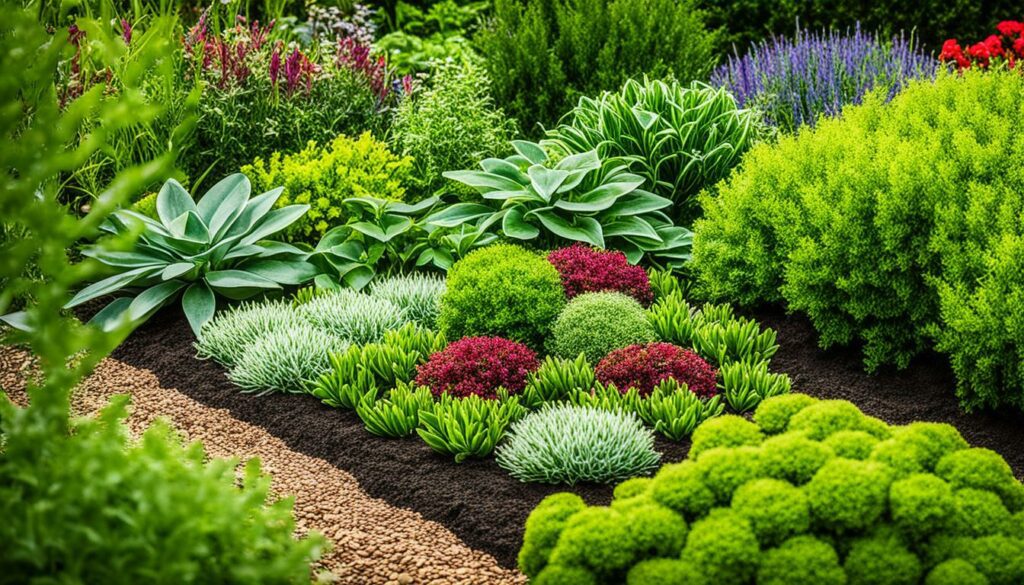
Different crops help the soil by providing and taking different nutrients. This practice, known as crop rotation, balances soil health and fights off pests. People have been using this method for ages, like in Europe and Asia, where they’ve kept the soil rich for hundreds of years. It keeps the soil’s nutrients in check and the bugs away, which means healthier plants.
Cover crops are plants grown not for food but to help the garden. They stop soil from eroding, keep nutrients in, kill off weeds, and add nutrients. When you grow different cover crops together, it helps more, since some plants can get nitrogen from the air. This makes for a more diverse, eco-friendly garden. It’s especially good for places like orchards and vineyards because it supports insects that help the crops grow.
Using these methods, farmers can grow good crops for a long time, without harming the environment. This is vital to ensure there is enough food both now and in the future.
Organic soil amendments are key for my garden’s health. They boost plant growth and help keep gardening eco-friendly. Such natural materials improve the soil’s condition and its ability to support plant life.
Manure is a top choice for enhancing soil. It’s packed with nutrients and betters the soil’s structure. For safety, composted manure must hit at least 131ºF over three days.
Manure from poultry, sheep, and rabbits is very nutritious. It helps plants grow strong.
Leaf mold is great for soil health, too. It’s made from decayed leaves and makes soil better at holding water. For best results, aim for 5%-10% soil organic matter content in vegetable and flower beds.
Using green manure is a must in my gardening. It means planting cover crops. These not only prevent soil loss but also keep the soil rich and full of life all year.
Water is getting scarcer and costlier worldwide. So, keeping soil moist is more important than ever. Mulching is key to this. It keeps soil cool, stops rapid drying, and maintains moisture in the soil. Putting 2-3 inches of organic mulch, like wood chips or straw, on top works well.
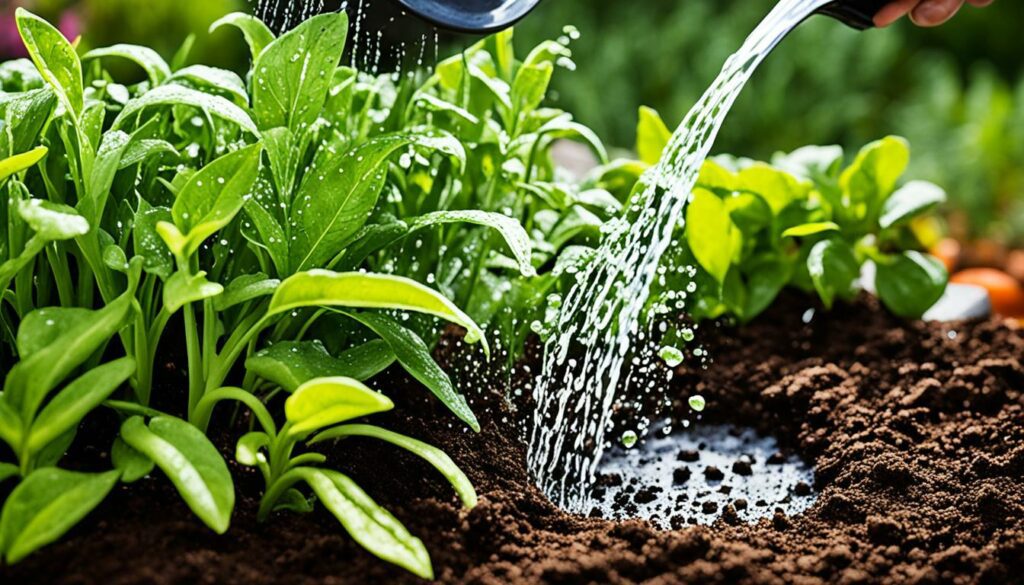
Adding more organic material to soil can help it hold water better. Soils full of organics can store more water, feed plants well, and stop soil from washing away. Using cover crops and compost is a good way to add organics. This makes soil healthier and better at keeping moisture in.
Cover crops can be vital for keeping soil damp. They cover the soil, blocking direct sunlight. This helps lower the rate at which water evaporates. Cover crops also put more water into the ground. They do this by making the soil easier to absorb water and by adding more organics to it.
“Increasing soil health and function can likely reduce inputs in farming systems.”
Experts in farming are now looking at water use in a new way. They’re focusing on getting more from each drop of water in the soil. This is because soil with high amounts of organics keeps moisture better. So, protecting soil and keeping it healthy are vital steps.
How we water our plants is very important too. It’s better to water deeply but not often. This makes plant roots grow down, which helps during dry times. Also, watering early or late in the day stops a lot of water from being lost as the sun dries it up.
Don’t forget about integrating animals with plants in farming. Animals can graze on cover crops. This doesn’t just add more organics to the soil. It also makes the soil’s structure better. A good soil structure holds water well, making everything in the ecosystem work together.
In summary, keeping soil moist with mulch, adding organics, sowing cover crops, and watering just right are vital. These steps help keep water in the soil. This means my plants can thrive.
| Method | Benefits |
|---|---|
| Mulching | Reduces evaporation, regulates soil temperature |
| Increasing Organic Matter | Improves water retention, reduces erosion |
| Cover Crops | Enhances water infiltration, adds organic matter |
| Deep Watering | Encourages deeper root growth, improves drought resistance |
| Livestock Integration | Enhances soil structure, boosts water retention |
In spring, new life brings potential threats to my garden. It’s important to keep pests away to protect your plants. Knowing how to keep your soil healthy can help you battle these enemies.
We need to understand soil life to keep pests in check. Good bugs and fungi are key to soil health and fighting off pests. Adding lots of natural material to your garden can make sure these helpful bugs have what they need to thrive.
Changing what you plant each season can stop pests from taking over. This practice also makes your soil healthier. Stopping too much nitrogen from going into the soil can help a lot too. This way, your plants are strong enough to fight off bugs without needing pesticides.
Healthy soil is key. When it’s at its best, it helps plants grow well and keeps pests low, naturally.
Checking your soil’s pH is a must for a healthy garden. The right pH helps plants get the nutrients they need. A balanced pH also helps good bacteria in the soil work better, protecting your garden from pests.
Garlic oil and smelly egg mixes can keep pests away without hurting the soil. These natural repellents work by confusing or repelling pests. They are a smart choice for keeping your garden safe.
Here’s a quick look at different ways to prevent pests and why they work:
| Method | Benefits | Example |
|---|---|---|
| Crop Rotation | Reduces disease, insects, and weed pressures | Alternating legumes and grains |
| Natural Repellents | Pest deterrence without chemical use | Garlic oil, putrescent egg |
| Precision Nitrogen Management | Minimises insect damage | Avoiding excess inorganic nitrogen |
| Maintaining Soil pH | Better micronutrient availability and pest resistance | Balanced pH levels |
Keeping soil safe from pests is a big job. By looking after the soil in a variety of ways, we can create a place where plants thrive and pests are kept at bay. This approach ensures strong garden protection during spring.
Raised gardening and managing soil in containers can make plants grow better. This method gives you more freedom and lets you control growing conditions. It’s key for a thriving garden.
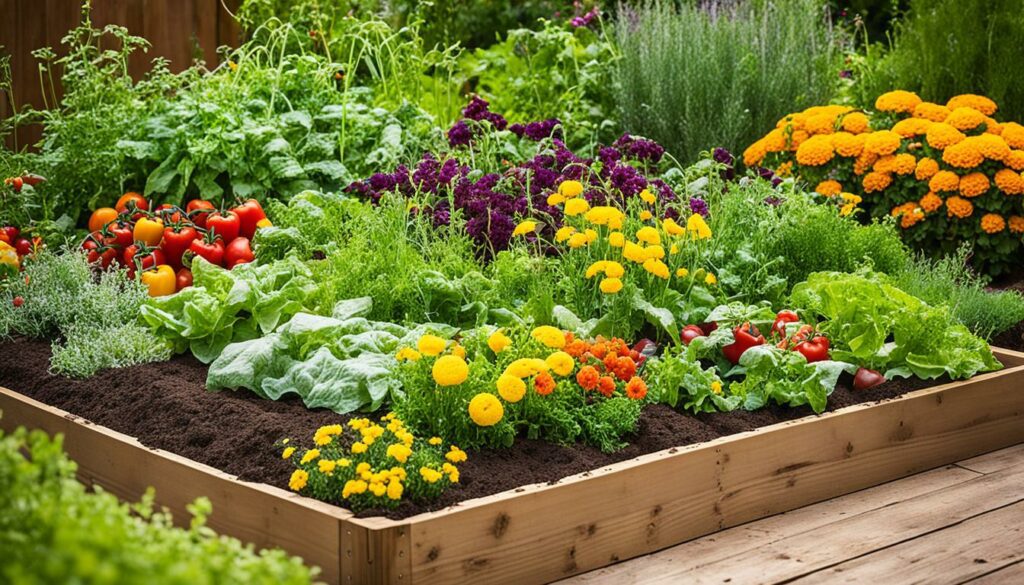
It’s vital to get the soil in your raised beds right. Recent studies show Mel’s Mix can give you 7 lbs per plant, the Perfect Soil Recipe 5.3 lbs, and bagged soil only 1.34 lbs. So, preparing your bed’s soil well is crucial for the best results.
| Soil Mix | Yield (lbs/plant) | pH | Phosphorus | Potassium | Zinc | Micronutrients |
|---|---|---|---|---|---|---|
| Mel’s Mix | 7 | 5.6 | Above optimum | Above optimum | Above optimum | – |
| Perfect Soil Recipe | 5.3 | 6.8 | Above optimum | Above optimum | Above optimum | High |
| Bagged Soil Mix | 1.34 | 7.5 | Above optimum | Above optimum | Above optimum | Erratic |
Refreshing potting soil is crucial for healthy plants. Regularly changing the soil and adding nutrients keeps plants strong. For example, fish bone or bone meal can boost phosphorus, important for plant health.
Keeping nutrient levels up in garden containers is essential. Adding compost or manure improves nutrients. Items rich in potassium, like wood ash and eggshells, also help. They keep the soil balanced for plants to grow well.
Checking the soil temperature is key for good seed growth. The best range for seeds to grow well is between 50-75°F. By keeping an eye on the soil temperature, you can protect your seeds from harm in cold, wet weather. This makes them less likely to get sick from diseases.
The right soil warmth is vital for planting success. Each type of plant needs different soil temperatures to start growing. For example, soybeans need 59°F while spring wheat needs only 37°F to begin. To make sure your soil’s warm enough, use soil sensors. They give instant and accurate data for when to plant.
Having a good soil thermometer is a must. It checks if the soil’s warm and ready for seeds. This tool confirms the temperature is just right for planting. It stops you from planting in soils that are too cold and wet. These soils can stop root growth and make plants sick with diseases like sudden death syndrome.
Using soil temperature info to change when you plant can boost growth. Soil temperature changes, so a three-day average helps pick the best times for planting. With soil sensors, you can track soil warmth overtime. This means you can plant at the perfect time for the best plant health and harvest.
For a spring garden boost, focus on making the soil healthier and prepping your garden well. Start by tidying up from winter, cutting back broken branches, and adding organic stuff to the soil.
It’s key to clean up the garden after winter. This step gets rid of leaves and mulch so the soil can breathe. It means new plants can grow better.
Prune branches early in spring to stop disease and let new growth happen.
The best time to prune trees and shrubs changes. For flowering plants like lilacs, wait until they bloom to prune them. This keeps the garden looking good and lively.
First, take away old mulch to avoid frost damage. Then, mix up what’s left to refresh it. Next, put down new mulch, making the soil healthy for plants.
Testing the soil shows what’s missing for plants to grow well. It helps you add the right things to the soil.
To check your soil’s pH, do a soil test. You can do it yourself or ask places like Flowerland to test it for you.
To boost soil nutrients, use things like compost and the right fertilisers. This makes the soil great for plant growth.
Good soil bacteria help turn dead stuff into food for plants. They’re vital for keeping the soil and plants healthy.
To make compost, mix green and brown materials. This keeps the compost pile working well. Soon, you’ll have great compost for your garden.
Use different strategies for each soil type. For clay, add organic material to help drain water. For sand, use compost to hold more water. And for loam, keep it perfect with regular organics.
To garden well, try no-till methods and switching crops around. Also, planting cover crops keeps the soil full of goodness and stops it from washing away.
Putting organic stuff like manure in the soil makes it better. It helps keep water, feeds the plants, and keeps them healthy.
To keep soil moist, use mulch, water rightly, and grow shade-providing plants. This is vital for your garden to flourish.
To fight off pests, use traps and natural repellents. This keeps your soil and plants safe while protecting the environment.
Raised beds and containers help with good drainage. They also let you add fresh soil easily to keep plants healthy.
Monitor soil temperature with a thermometer to know when to plant. When it’s about 56 degrees, it’s ready. This improves how your garden grows.